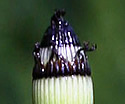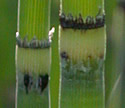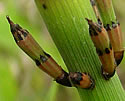Equisetum laevigatum (Smooth Scouring Rush)
| Also known as: | |
|---|---|
| Genus: | Equisetum |
| Family: | Equisetaceae (Horsetail) |
| Life cycle: | perennial |
| Origin: | native |
| Habitat: | part shade, sun; sandy or gravelly soil; wet meadows, ditches |
| Fruiting season: | late spring, summer |
| Plant height: | 1 to 4 feet |
| Wetland Indicator Status: | GP: FAC MW: FACW NCNE: FACW |
| MN county distribution (click map to enlarge): |  |
| National distribution (click map to enlarge): |  |
Pick an image for a larger view. See the glossary for icon descriptions.
Detailed Information
Leaves and stems:
![[photo of stem sheath]](/udata/r9ndp23q/pd3/equisetum-laevigatum-79807-5-t.jpg) The sterile stem is green and usually has no branches, though short stubby branches may develop on some plants. The “leaves” are reduced to a sheath that surrounds the stem, with 10 to 32 black teeth around the top. The teeth fall off as the season progresses, leaving a thin dark ring around the top of the sheath.
The sterile stem is green and usually has no branches, though short stubby branches may develop on some plants. The “leaves” are reduced to a sheath that surrounds the stem, with 10 to 32 black teeth around the top. The teeth fall off as the season progresses, leaving a thin dark ring around the top of the sheath.
![[photo of stem cavity]](/udata/r9ndp23q/ferns/equisetum-laevigatum_0726_122855-t.jpg) The stem is firm, the central cavity mostly ½ to ¾ the diameter of the stem.
The stem is firm, the central cavity mostly ½ to ¾ the diameter of the stem.
Fruit: 
![[photo of spore cone]](/udata/r9ndp23q/pd3/equisetum-laevigatum-789-6-t.jpg) Fertile stems are like sterile stems, but with a ½ to 1 inch long cone at the tip of the stem. Cones have a blunt tip or may have a tiny, inconspicuous sharp tip.
Fertile stems are like sterile stems, but with a ½ to 1 inch long cone at the tip of the stem. Cones have a blunt tip or may have a tiny, inconspicuous sharp tip.
Notes:
Smooth Scouring Rush is one of three similar, unbranched Equisetum species in Minnesota, the others are Tall Scouring Rush (E. praealtum, a.k.a. E. hyemale) and Variegated Scouring Rush (E. variegatum). In the early part of the season, E. laevigatum can be identified by the entirely black teeth; later in the season by the lack of teeth and the dark ring around the top of the sheath. E. praealtum also has black teeth but has a black band around the base of its pale gray sheath and often the tip as well. E. variegatum is further distinguished by its fewer and larger persistent teeth with distinct white edging. E. laevigatum hybridizes with E. praealtum, producing E. × ferrissii, and with E. variegatum, producing E. × nelsonii.
Native Plant Nurseries, Restoration and Landscaping Services ↓
More photos
 Smooth Scouring Rush plants
Smooth Scouring Rush plants early season stems
early season stems mature stems
mature stems late season stems
late season stems atypical branching
atypical branching Smooth Scouring Rush on sandy prairie
Smooth Scouring Rush on sandy prairie
Photos by K. Chayka taken in Ramsey County. Photos by Peter M. Dziuk taken in Anoka and Hennepin counties.
Comments
Have you seen this plant in Minnesota, or have any other comments about it?
on: 2017-07-22 20:07:49
I have seen this plant for years...thanks to Mn Wildflowers, and the distribution map I am confidant of my ID...prehistoric plant...in the fossil record.
on: 2018-01-26 16:59:55
There's something strikingly like this going up all the streams and rivers in Duluth. Not sure if it's this or the Invasive Species of Zebra Bamboo.






